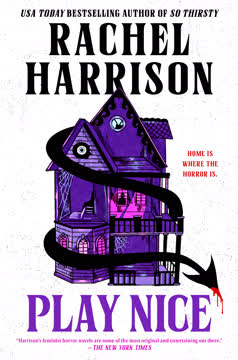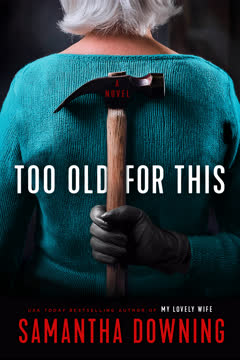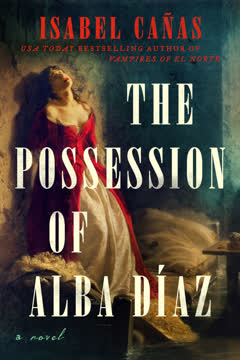Plot Summary
Glitter, Grief, and Ghosts
Clio Barnes, a stylish, sharp-tongued New Yorker, navigates a glittering party on the night she learns her estranged mother, Alexandra, has died. The news is a jolt, but Clio's response is complicated—her mother was infamous for her instability, her belief in demons, and her abandonment of Clio and her sisters. As Clio leaves the party, she's haunted not just by memories but by the sense that her mother's legacy—her chaos, her pain, her supernatural obsessions—has not died with her. The city's noise and Clio's bravado can't drown out the ghost of her mother, or the unresolved wounds she left behind.
Sisters, Secrets, and Scars
Clio returns to her childhood home in New Jersey, where her sisters, Leda and Daphne, and their father and stepmother, Amy, gather in the wake of Alexandra's death. The sisters' dynamic is fraught: Leda is rigid and controlling, Daphne is the peacekeeper, and Clio is the wild card. Their shared history is a minefield of secrets, blame, and trauma, especially around their mother's mental health and the infamous haunted house of their childhood. The sisters debate whether to attend Alexandra's funeral, each wrestling with their own version of the past and their mother's legacy.
The Funeral and the Book
Clio, accompanied by her brother-in-law Tommy, attends Alexandra's funeral in Connecticut, where she's thrust into her mother's world of spiritualists, psychics, and believers. She meets Roy, her mother's partner, and Aunt Helen, who reveals that Alexandra never sold the haunted house on Edgewood Drive. Clio learns she and her sisters have inherited it. At the funeral, Clio is given a copy of her mother's out-of-print memoir, Demon of Edgewood Drive, annotated with personal notes. The book becomes a Pandora's box, promising answers but threatening to unravel Clio's sense of self.
Haunted Inheritance
Clio visits Edgewood Drive, the house of her childhood nightmares. The place is frozen in time, filled with memories and the residue of her mother's obsession with the supernatural. As Clio explores, she's unsettled by strange occurrences—spinning fans, cold drafts, and the sense of being watched. She finds her childhood room untouched, a book left for her by her mother, and a scar on her arm she can't quite remember getting. The house is both a physical inheritance and a psychic burden, a place where the past refuses to stay buried.
Return to Edgewood
Determined to reclaim the house, Clio decides to renovate Edgewood, documenting the process for her social media followers. She's joined by Austin, a neighbor from her past, and the two spark a romance amid the chaos. But the house resists change—mice infestations, mold, and inexplicable phenomena escalate. Clio's nights are plagued by nightmares, sleepwalking, and the sense that the house is alive, feeding on her energy. The more she tries to control the narrative, the more the house—and her mother's story—push back.
The Demon's Games
As Clio reads her mother's memoir, the line between memory and fiction blurs. The book recounts Alexandra's descent into paranoia, her attempts to exorcise the house, and her belief that a demon targeted Clio as a child. Clio experiences increasingly disturbing events: messages appear in her sketchbook, objects move on their own, and the house seems to communicate with her. Her sisters and father dismiss her fears, attributing them to stress or mental illness. Clio is caught between skepticism and belief, unsure if she's haunted by a demon or by her family's trauma.
Family Lies, Family Ties
Tensions explode as Clio's obsession with the house and the book alienate her from her family. Old lies are exposed: the truth about her childhood burn, her mother's drinking, and her father's infidelity. The sisters' relationships fracture under the weight of blame and resentment. Clio's mental state deteriorates—she drinks, isolates herself, and lashes out. The house becomes a battleground for the family's unresolved pain, each member forced to confront their role in the past and their complicity in the present.
Exorcisms and Explanations
The memoir's climax details Alexandra's failed exorcism, a chaotic event involving priests, psychics, and violence. The demon, whether real or metaphorical, resists all attempts to be banished. Clio, reading these accounts, is both horrified and skeptical—her own memories don't match her mother's narrative. She seeks out Roy, who confirms that much of the memoir was embellished, but insists the haunting was real. The exorcism becomes a metaphor for the family's struggle to rid themselves of inherited pain, and for Clio's own battle to distinguish truth from fiction.
The House Remembers
Clio's grip on reality frays as the house's influence intensifies. She discovers hidden objects in the attic—childhood drawings, mementos, and more annotated copies of her mother's book, each addressed to a different sister. The demon, or the house itself, seems to feed on Clio's emotions, growing stronger as she succumbs to fear and despair. The sisters are drawn back to Edgewood, where the house orchestrates a final confrontation, forcing them to relive their worst memories and to face the truth about their mother, themselves, and the nature of evil.
Love, Loss, and Laughter
In the house's grip, the sisters' resentments boil over into physical and emotional violence. The demon's laughter echoes through the walls as the family's secrets are laid bare. Clio realizes that the house—and the demon—thrives on their suffering, their need for attention, and their refusal to let go. In a moment of clarity, she offers the demon her most prized possession, symbolically breaking the cycle of attachment. The sisters, battered but united, escape the house, leaving behind the ghosts of their past.
Breaking Points
The aftermath is a reckoning: Clio's father admits his failings, the sisters confess their betrayals, and the family's carefully constructed narratives collapse. Clio is hospitalized, her mental health in question, but she emerges with a new understanding of herself and her family. The house is put up for sale, but its legacy lingers. Clio's relationships are changed—some healed, some irreparably damaged. The demon, whether real or imagined, has left its mark.
Truths in the Attic
Clio returns to Edgewood one last time, climbing into the attic where the demon resides. There, she confronts the embodiment of her family's pain—a creature both monstrous and familiar. She offers it her grief, her anger, and her love, recognizing that the only way to break free is to stop playing its game. The demon recedes, sated or defeated, and Clio descends, changed. The sisters, together, leave the house behind, their scars visible but their bond intact.
Letting Go, Moving On
The sisters gather at McDonald's, battered but alive, sharing a meal that is both mundane and sacred. They reflect on their mother, their scars, and the impossibility of ever fully understanding the past. Clio finds peace not in answers, but in acceptance—of her mother's flaws, her family's failures, and her own resilience. The house is sold, the demon left behind, and Clio steps into a new life, determined to play nice with her own demons.
After: New Beginnings
Months later, Clio has reinvented herself, channeling her pain into art and success. Her family is changed but still present, their wounds acknowledged if not healed. The haunting of Edgewood Drive becomes a story, a lesson, and a warning. Clio knows that demons—real or metaphorical—never truly disappear, but she also knows she has the power to choose what she gives them. The past is not erased, but it no longer defines her. She faces the future with hope, humor, and hard-won wisdom.
Characters
Clio Barnes
Clio is the youngest Barnes sister, a fashion stylist and influencer whose sharp humor masks deep insecurity and unresolved trauma. She is both the family's rebel and its emotional center, craving attention but fearing vulnerability. Clio's relationship with her mother is fraught—she is both her mother's favorite and scapegoat, inheriting Alexandra's beauty, volatility, and capacity for self-destruction. Throughout the novel, Clio's journey is one of self-discovery: confronting the truth about her childhood, her family's lies, and the possibility that the house's haunting is both supernatural and psychological. Her arc is a struggle for agency, authenticity, and acceptance of her own scars.
Leda Barnes
The eldest sister, Leda is defined by her need for order and her refusal to show weakness. She distances herself from her mother's chaos by embracing discipline and achievement, but beneath her perfectionism lies deep hurt and jealousy. Leda's relationship with Clio is antagonistic—she sees Clio as reckless and selfish, yet envies her freedom. Leda's arc is about confronting her own complicity in the family's dysfunction, her suppressed longing for attention, and her inability to let go of control. Her breakdown in the haunted house reveals the cost of denial and the necessity of vulnerability.
Daphne Barnes
The middle sister, Daphne is the family's mediator, always smoothing over conflicts and absorbing others' pain. She is nurturing but self-effacing, often sacrificing her own needs to maintain harmony. Daphne's relationship with Clio is closest, but also codependent—she both supports and resents Clio's drama. Daphne's arc is about finding her own voice, acknowledging her anger, and refusing to carry the family's burdens alone. Her breakdown in the house is a catharsis, allowing her to express long-suppressed rage and grief.
Alexandra Barnes
The sisters' mother, Alexandra is a complex figure: a woman undone by trauma, addiction, and belief in the supernatural. Her memoir, Demon of Edgewood Drive, is both confession and self-justification, blending truth and fiction. Alexandra's love for her daughters is real but warped by her own pain—she both protects and harms them, seeking connection but causing chaos. In death, she becomes a ghostly presence, her legacy a haunting that the sisters must confront and ultimately forgive.
James Barnes (Dad)
The sisters' father, James is outwardly reliable and loving, but his need for control and his refusal to acknowledge his own failings contribute to the family's dysfunction. He manipulates narratives to protect himself, casting Alexandra as the villain and himself as the savior. His arc is one of reluctant confession—admitting to infidelity and to the ways he failed his daughters. His love is real but conditional, and his inability to accept messiness perpetuates the family's pain.
Amy
The sisters' stepmother, Amy is a former dance teacher who tries to fill the void left by Alexandra. She is nurturing but never fully accepted, her presence a reminder of the family's fractures. Amy's role is to offer comfort and stability, but she is also complicit in the family's avoidance of difficult truths. Her relationship with the sisters is affectionate but shallow, and her own guilt and insecurities surface in moments of crisis.
Roy
Alexandra's partner and a self-styled demonologist, Roy is both a source of comfort and a catalyst for Alexandra's obsessions. He validates her belief in the supernatural, participating in exorcisms and rituals. Roy's motivations are ambiguous—he claims to want to help, but his presence prolongs Alexandra's attachment to the house and her delusions. In the present, he offers Clio support, but his own complicity in the family's suffering is undeniable.
Aunt Helen
Alexandra's sister, Helen is estranged from the family but serves as a source of hard truths and alternative perspectives. She is blunt, unsentimental, and fiercely loyal to Alexandra, often clashing with James and the sisters. Helen's role is to challenge the family's narratives, urging Clio to seek her own answers and to forgive her mother. She represents the possibility of healing through honesty, even when it is painful.
Austin
A childhood acquaintance and Clio's romantic interest, Austin is a nurse who offers Clio genuine affection and stability. He is grounded, empathetic, and unafraid to challenge Clio's defenses. Austin's presence in the story is a counterpoint to the chaos of Clio's family—he represents the possibility of healthy connection and the courage to face the past. His own struggles with family and loss mirror Clio's, deepening their bond.
The Demon / The House
Whether supernatural or psychological, the demon of Edgewood Drive is the embodiment of the family's pain, secrets, and need for validation. It feeds on chaos, thrives on attention, and resists exorcism. The house itself becomes a character—alive, watchful, and hungry for suffering. The demon's games mirror the family's dynamics: cycles of blame, denial, and desperate bids for love. Its ultimate power lies in its ability to make the family confront their own darkness.
Plot Devices
Unreliable Narration and Blurred Reality
The novel's structure alternates between Clio's present-day perspective and excerpts from Alexandra's memoir, Demon of Edgewood Drive. This dual narrative blurs the line between fact and fiction, forcing readers to question what is real and what is constructed. The unreliable narration is heightened by Clio's psychological unraveling and the house's supernatural phenomena, creating a sense of disorientation and ambiguity. The memoir's footnotes, Clio's annotated memories, and the sisters' conflicting accounts all serve to destabilize the narrative, mirroring the characters' struggle to make sense of their past.
The Haunted House as Metaphor
Edgewood Drive is both a literal haunted house and a metaphor for inherited trauma. The house's resistance to renovation, its preservation of childhood rooms, and its supernatural manifestations all symbolize the family's inability to move on from the past. The demon's attachment to Clio and her mother represents the cyclical nature of pain and the difficulty of breaking free from destructive patterns. The house's attic, filled with mementos and memories, becomes the site of final reckoning—a place where the past must be confronted and released.
Family Dynamics and Generational Trauma
The novel's central plot device is the interplay of family roles—scapegoat, golden child, peacekeeper—and the ways in which trauma is passed down and perpetuated. The sisters' arguments, their father's manipulations, and their mother's confessions all serve to illustrate the complexity of familial love and the impossibility of simple resolutions. The demon's games are a dark mirror of the family's own dysfunction, and the exorcism becomes a metaphor for the painful process of healing.
Attention, Performance, and Social Media
Clio's career as an influencer and her obsession with documenting her life are woven into the narrative as both coping mechanism and curse. The need for attention—whether from family, followers, or the supernatural—drives much of the action. The novel uses social media as a modern form of haunting, where the past is never truly gone and the self is always on display. The viral fallout from Clio's breakdown echoes the demon's hunger for chaos and the dangers of living for an audience.
Foreshadowing and Circular Structure
The novel is rich with foreshadowing—early references to scars, snakes, and laughter recur throughout, culminating in the final confrontation in the attic. The story's structure is circular: it begins and ends with parties, with Clio performing for others, haunted by what she cannot escape. The repetition of "hello," the motif of doors opening and closing, and the return to Edgewood all reinforce the theme that some stories, and some wounds, never truly end.
Analysis
Rachel Harrison's Play Nice is a razor-sharp, darkly funny exploration of family trauma, the hunger for attention, and the blurred boundaries between the supernatural and the psychological. At its core, the novel asks what it means to be haunted—not just by ghosts, but by the stories we inherit, the lies we tell, and the pain we refuse to let go. Through Clio's voice—witty, wounded, and deeply self-aware—the book interrogates the ways women are labeled "crazy" for feeling too much, wanting too much, or refusing to play nice. The haunted house is both a literal site of horror and a metaphor for generational pain, a place where the past is preserved and the future is always at risk. The demon, whether real or imagined, is a stand-in for the insatiable need for validation, the chaos of family, and the seductive power of suffering. Harrison's narrative structure—fragmented, annotated, and unreliable—mirrors the characters' fractured sense of self and the impossibility of a single, objective truth. Ultimately, Play Nice is a story about survival: the courage to confront what haunts us, the necessity of forgiveness, and the messy, ongoing work of choosing hope over despair. It's a modern gothic for the age of Instagram, a reminder that our demons are real, but so is our capacity to outgrow them.
Last updated:
Review Summary
Play Nice is a haunted house thriller with dark humor and family drama. Readers praised Harrison's sharp writing, complex characters, and creepy atmosphere. Many found the protagonist Clio unlikeable yet compelling. The book blends supernatural elements with psychological tension, exploring themes of trauma, mental health, and dysfunctional families. While some wished for more overt horror, most enjoyed the slow-building dread and twisty plot. Reviewers appreciated the book-within-a-book structure and annotations. Overall, it's seen as a unique, layered, and entertaining read perfect for spooky season.








